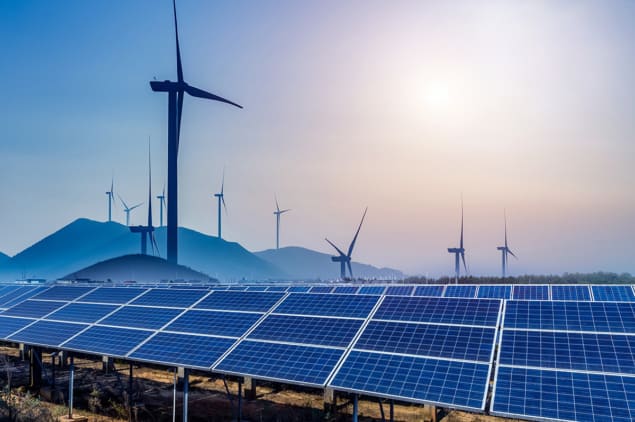
A new study by the Energy Watch Group in Berlin and Lappeenranta University of Technology (LUT) in Finland outlines a “technically feasible and economically viable energy pathway for Europe, in which the energy sector (comprising power, heat, transport, and desalination) can reach 100% renewable energy and zero greenhouse gas emissions by 2050”.
The report, launched on the sidelines of the COP climate summit in Poland last December, claimed that the transition could be achieved using existing renewable energy technologies: “The energy transition is not a question of technical feasibility or economic viability, but one of political will.” What’s more, it would create at least one million more jobs in energy and be more cost-effective than the present fossil fuel-based system.
Primary energy demand would fall from 21,000 TWh in 2015 to just under 20,000 TWh by 2050, as a result of “massive” energy efficiency gains and an over 85% electrification rate, with fuel consumption reduced by more than 90% from 2015 levels as fossil fuels were almost entirely phased out by renewables. Solar photovoltaics (PV) would lead, becoming the lowest cost energy source and generating 62% of electricity by 2050, followed by wind energy at 32%, hydro at 4%, bioenergy at 2% and geothermal energy at less than 1%. Storage capacity would meet nearly 17% of electricity demand and around 20% of heat demand, from heat stores, but “electric heat pumps will also play a significant role, generating more than 30% of heat on district and individual levels by 2050”.

Rethinking power: pipes versus wires
Despite all these changes, the Energy Watch Group and LUT say that the overall Levelized Cost of Energy would remain stable between 2015 and 2050, at between €50–60/MWh. For electricity, levelized costs are predicted to “substantially” decrease, from around €80/MWh in 2015 to around €57/MWh by 2050, while the levelized costs of heat would increase “marginally” from around €41/MWh in 2015 to around €43/MWh by 2050. But there would be significant employment increases — a total of 3 – 3.5 million jobs by 2050 compared with 2 million now in the European energy sector. Most of the new jobs, some 1.7 million, would be in PV solar. Powerful stuff, though a tad optimistic.
A more cautious view
Looking globally, a somewhat more cautious approach was taken by Jesse Jenkins from Harvard University, US, and two colleagues, who co-authored a paper that summarizes insights from 40 high-renewables studies. The publication outlines two broad global pathways to decarbonize electricity: one relying primarily on wind and solar power with support from storage, demand flexibility, and transmission expansion, and a second harnessing these options alongside “firm” low-carbon resources such as nuclear, geothermal, biomass and carbon capture and storage (CCS). It says that both routes may be feasible but must overcome several challenges.
The study found that high-renewable scenarios, based on wind and solar, relied on a number of factors occurring at once – the construction of long-distance grids, more flexible demand, cheaper batteries and long-duration storage technology that’s not currently available at scale. Otherwise, cost and technical challenges would mount. That’s a bit more cautious than some other studies that, like Jacobson et al. from Stanford University, US, have claimed that near 100% solar-, wind- and hydro-based scenarios could be achieved and balanced using existing technology with no nuclear, biomass or fossil CCS. As noted above, the Energy Watch Group/LUT study, which is part of a suite of LUT studies including a global report, said no new technologies were needed. By contrast, the Harvard study concluded that “improving and expanding the portfolio of available low-carbon resources offers a greater likelihood of affordably achieving deep decarbonization”. It wants a broader mix.

100% renewable electricity is viable
Clearly, there’s no shortage of scenarios with renewables racing ahead, although some of them are less optimistic about the results in terms of carbon reduction. For example, a study by consultants Wood Mackenzie has wind and solar growing to supply under 40% of power by 2040. Hydro also goes up a bit while the small nuclear input falls slightly. However, gas use still rises steadily and although coal use is almost halved and oil falls back slightly, overall in total energy terms it’s still a 77% fossil future.
A similarly sobering view from the American University in Cairo says that although renewables are going ahead around the world, that’s not happening fast enough to cut growing emissions. Renewables will have to scale up massively, in the Middle East especially. That is hardly news; the Saudis have evidently cut back on their ambitious “200 GW by 2030” solar plans to around 58 GW, and the IEA has warned that global emissions will rise unless more is done everywhere.
Can we do better?
So what is the current state of play? It is true that renewables growth has slowed in some places of late, including in Germany, often seen as the pathfinder. A recent article from Yale University, US, discusses a think tank report that if Germany continues on its present course, its carbon emissions will fall by only 62% by 2050. That’s well below its 80% emissions cut target, with transport being a key problem. However, there are plans from the influential German industry federation BDI to try to get back on track. It even looks at a 95% scenario.
The BDI says that 80% is “technically and economically feasible” but 95% “would push the boundaries of foreseeable technical feasibility and current social acceptance”. While “assuming optimal political implementation, the climate paths’ macroeconomic effects would be neutral to slightly positive, for an 80% ambition even without global consensus”, it warns that the 95% path would need a global consensus – Germany could not go it alone.
In the absence of that consensus, with the US outside the Paris COP agreement, we are left with individual countries doing their best independently. In addition to the BDI plan, however, there are other positive signs from within the EU. Spain now reportedly plans to switch to 100% renewable power by 2050, and completely decarbonize its economy soon after. The nation already has around 48 GW of renewables in place, including 20 GW of hydro, 23 GW of wind and (oddly) only 5 GW of PV solar, plus 2.3 GW of concentrated solar power (CSP). Now Spain will install at least 3 GW more wind and solar power capacity every year for the next 10 years.
Denmark is still making good progress; consumption of coal fell by 25% in 2017, while consumption of renewable energy increased by just over 11%, to roughly 55% of electricity. Overall, Denmark’s energy-related carbon dioxide emissions continued to fall, dropping by 38% since 1990. In the Netherlands, meanwhile, new subsidy-free wind projects are emerging. As costs fall, there are also plans for subsidy-free PV projects in the UK, with the Solar Trade Association predicting that PV may get down to £40/MWh by 2030. Onshore wind could reach that too, if the current government blocks were removed. So, with offshore wind booming, the UK could have well over 60 GW of renewables in place by 2030, up from around 43 GW.
The UK is soon, it seems, to be outside the EU. And elsewhere in the EU, progress is more uncertain. Before it took power two years ago, the Five Star party in Italy called for a 100% renewable Italy. Now in power, its leader and deputy prime minister Luigi Di Maio said, “Italy has decided in a serious way to aim for an entirely sustainable energy future”. The country has about 52 GW so far and aims for a 28% energy share by 2030, up from about 18%. But, reportedly, limits may be placed on some projects due to the cost, with geothermal constrained by new draft rulings. Some see that as indicating a change of view and as a sign of the impact of the new populism allegedly sweeping Europe.
That certainly has had an impact in France. The new PPE energy plan calls for a big step up from the 47 GW of renewables — including 25 GW of hydro — currently in place, with wind expanding threefold from 11 GW and solar fivefold from 8 GW, along with the development of other renewables. Given the populist backlash, there may have to be adjustments to the energy tax plan. In response to the riots in Paris, the government backed off the fuel price rises, as did the UK government back in 2000 when faced with lorry driver protests. But no one benefits long-term from burning dirty fuel, except maybe the oil companies, although the costs of cleaning up must be shared fairly and reduced as far as possible. A big issue for the future is whether the fall in cost for renewables will be sufficient to allow them to expand fast enough to keep planetary and political temperatures down.
In my next post, by way of wider context, I will look at the European Commission’s latest — and quite bold — plan for “net zero emissions” by 2050.



